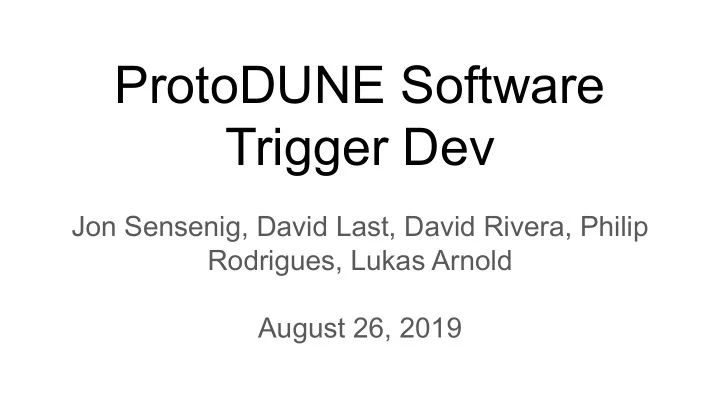

ProtoDUNE Software Trigger Dev Jon Sensenig, David Last, David Rivera, Philip Rodrigues, Lukas Arnold August 26, 2019
Data Flow Schematic of the current data flow ● development in ProtoDUNE. ● Hit-sending BR no longer necessary for Felix BR hit-finding APAs (due to artDAQ changes). Keep them under consideration but running w/o them now. 2
Candidate BR Window TPSets into Serialize TPSets 1. Aggregate and channel 50us windows (for from all links into sort TPs each link) single time-ordered 2. Find adjacency, using stream adjacency algorithm to generate TCs Data flow in the Candidate BR ● Candidate BR is for a single APA, (in ProtoDUNE, APA5: trigcand500, ● APA6: trigcand600) 3
MLT BR Time order TCs - Aggregate TCs Generate artDAQ streams from - Coincidence or Stitch TCs fragment different APAs - Generate Trigger Decision with coincidence or stitching algorithm MLT pushes it’s artDAQ fragment, initiating the readout from the other BRs. ● “To Felix BR” tells the Felix BR to compress the data in anticipation of a data request. ● Algorithms currently looking for muons that cross both APAs. ● 4
Candidate Algorithm ● (1) Receive set of time windowed (50µs) and channel sorted TPs ○ (2) Check for adjacency across channels within time window for an APA (allow hit wire gap <= 4) ○ (3) Returns largest adjacency, includes adjacency endpoint coordinates (channel, time) ○ (4) Generate TC if returned adjacency is >=300 (TC coincidence) or >=100 (TC stitching) ○ 5
Module Level Algorithm (super simple) ● (1) TC time window coincidence ○ Set adjacency threshold large (>300 adjacent wire hits) at candidate level ■ Compare each TC timestamp to the next ■ If timestamp difference of TC A,B < time window and they’re from different APAs → trigger! ■ (i.e. IF TC_A_apanumber != TC_B_apanumber AND time_difference < 50us → trigger) ■ 6
Quick First Look (Upstream) 5 ← APA → 6 (Middle) 7
Quick First Look cont. Some caveats, Very loose matching condition for matching TCs between APAs ● High adjacency can be faked by high activity within a time window (see above) ● Still very useful to have for higher trigger rates (a few Hz) ● 8
Module Level Algorithm (more robust) ● (1) TC stitching ○ Set adjacency threshold (>100 adjacent wire hits) at candidate level ■ TCs time ordered and aggregated for a drift using a sliding window ■ Calculate the TC slope in time-channel space (m = Δt / Δchannel) ■ Check the slope, time and channel difference between TCs to see if they form a track ■ If the stitched TCs together result in >=350 hits in each APA → trigger ■ 9
Quick First Look (Upstream) 5 ← APA → 6 (Middle) 10
Summary & To-Do Physics trigger! ● First look, algorithms working as expected, but need to take a detailed look ● at more events. Take longer run to gather more statistics, very low rate ~9min per trigger. ● Local updates to the algorithm wrapper (ptmp-tcs) need to be packaged and ● released for more general use. 11
Recommend
More recommend